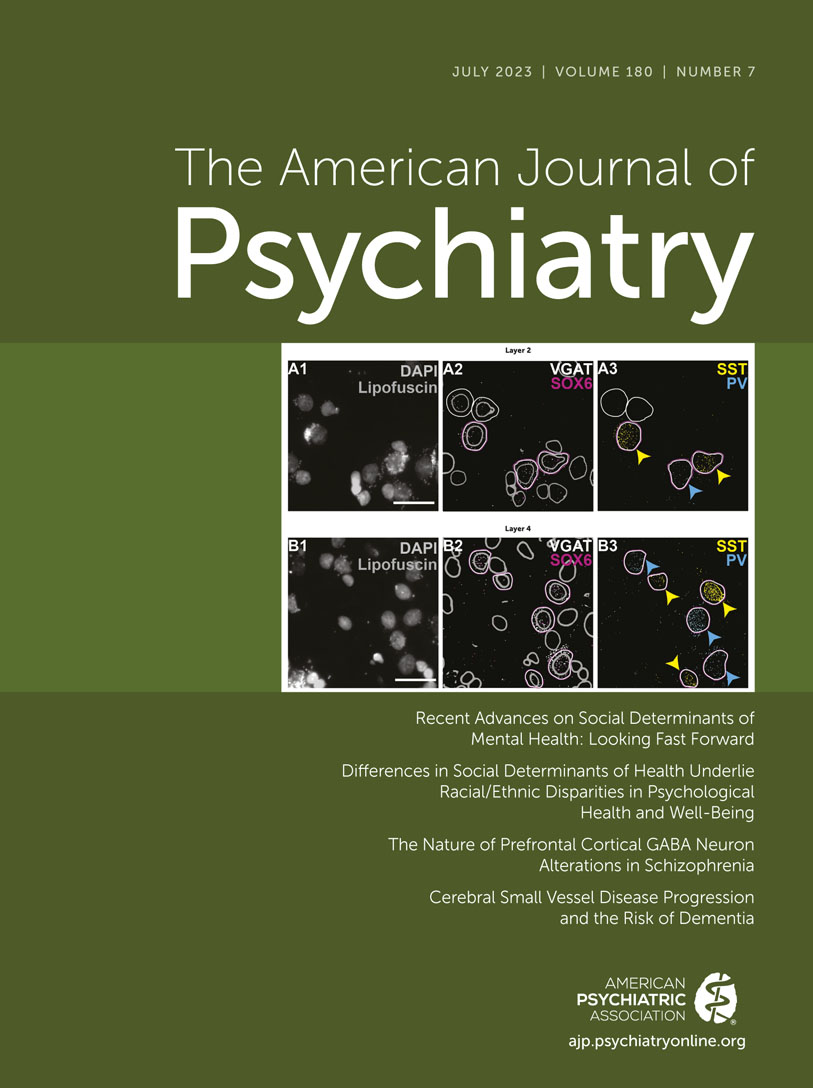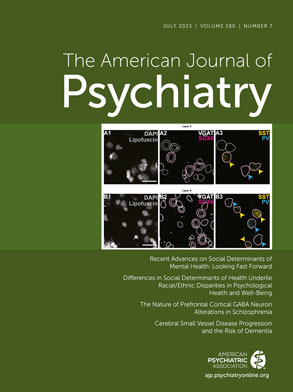The priority data letter by Joshi and colleagues in this issue of the
Journal (
1) elegantly describes the potential use of auditory event-related potentials (ERPs) for understanding both the biological basis of circuit abnormalities in schizophrenia and the impact of anticholinergic activity on these circuits. Auditory ERPs are created by presenting stimuli (tones or clicks) dozens to hundreds of times and recording electroencephalographic (EEG) responses following each stimulus. This EEG response is recorded via scalp electrodes as a continuous stream of data during the period following each stimulus and contains the summation of all brain activity occurring at that time. Each electrode is like an electrical “microphone,” listening to millions of musical instruments simultaneously—neurons in the entire brain—and combining what it hears into a single output. Unlike music, electrical brain activity can register either as a positive or negative signal at any given moment. Since the brain activity response to the auditory stimulus occurs identically (i.e., neural activity at the same time and in the same way) after each stimulus, that pattern of brain activity will be represented within the EEG response after each stimulus. However, brain activity that is unrelated (and therefore not time-locked) to the stimulus (e.g., visual, olfactory, tactile, or cognitive activity), will generate a series of random positive and negative voltage values, such that their average over many trails will be zero. As such, the averaged activity in the periods following the stimuli will retain auditory-related activity and remove the unrelated activity. The resulting ERP is demonstrated in Figure 1 of the report by Joshi and colleagues. Resulting components of the auditory ERP are typically named using a convention that combines their direction (positive or negative) and either their timing or order after a stimulus. For example, P denotes a positive deflection and N denotes a negative one. The number following the P or N can denote the number of milliseconds (msec) after stimulus onset, e.g., the P50 is a positive deflection at 50 msec after the stimulus while the N100 is a negative deflection at 100 msec after onset. Alternatively, these components can also be named by their order, such that the P1 is the first major positive deflection while the N1 is the first major negative deflection after a stimulus. Joshi and colleagues focus on two components of the auditory ERP response, mismatch negativity (MMN) and P3a, which refer to changes in the pattern of neural response following a change in auditory stimulus characteristics. The MMN occurs as an exaggerated negative deflection directly following the N1 or N100, while the P3 is the third major positive deflection, which is manifest as an exaggeration of the positive deflection following the P2. Both components are elicited when there is a change in qualitative features of a consistent repetitive stimulus (e.g., tone of the stimulus) (
2).
Many previous studies have employed auditory ERPs to query the integrity and fidelity of neuronal synchrony and connectivity across brain regions. For a comprehensive review of EEG biomarkers, please see the review by Javitt and colleagues (
3). The study by Joshi et al. follows previous work by the authors isolating the anticholinergic contribution of various medications as a causative factor in cognitive disability. It then uses deviance-related ERPs as a tool to detect such disturbance and therefore predict potential adverse cognitive consequences of future medications during clinical trials. There are many reasons why the MMN and P3a ERPs are a powerful translational tool, including the ability to control quantitative features of the inputs to a circuit, as well as measuring neuronal processing within and between specific brain regions. Furthermore, this approach allows for preclinical studies that manipulate and isolate the contribution of various genes, neurotransmitters, and pharmacological agents on ERPs (
4,
5). However, different studies often ascribe different pharmacological causes for the same outcomes. For example, one study may test the isolated impact of dopamine on ERPs, while another may show similar effects the impact of glutamate on the same ERPs (
2). Additionally, antipsychotics, as well as medications that counteract their side effects, have diverse pharmacological properties, making it difficult to ascribe the impact of a drug’s activity at any one neurotransmitter system to their effects on ERPs (
6).
Prior efforts to predict clinical outcomes of a potential therapeutic agent using preclinical behavior, electrophysiology, and molecular data in rodents have yielded mixed success (
7). Additionally, correlational studies linking various ERP components to specific human clinical domains have not consistently translated to the predictive ability to pharmacologically manipulate an ERP component and subsequently move a human clinical outcome (
8). This is likely because ascribing any one mechanism for a specific ERP deficit (e.g., glutamatergic contribution to reduced N1 amplitude) is unlikely to account for the full constellation of etiologies and pathophysiologies for that electrophysiological change across different people and disease states (e.g., schizophrenia). That is, if MMN is diminished by a variety of factors, it is impossible to know which of those factors is contributing to that diminution in a specific clinical population, let alone a specific person. Similarly, several factors (e.g., genes, medications, developmental events) may be simultaneously at play in humans, such that remediating any one is insufficient to move the relevant circuit in a way that maps on to cognitive or emotional performance. The current study addresses this limitation by examining the association between antimuscarinic cholinergic activity and MMN/P3a amplitude while controlling for other pharmacological factors that might impact these measures. It does so by using a tool that consolidates anticholinergic binding affinity and concentration to a single dimension on a six-point scale. This approach is similar to that used in landmark studies of antipsychotic medications to approximate receptor occupancy in vivo and definitively demonstrate that these medications work through binding at dopamine type two (D2) receptors (
9,
10). It would be helpful to address the specificity of the relationship between cognitive impairment and anticholinergic activity by performing similar analyses for the myriad pharmacologic activities of antipsychotic and other agents, including binding at serotonergic, histaminic, noradrenergic, and other neurotransmitter systems. Future studies could replicate the approach by Joshi et al. to evaluate the extent to which other neurotransmitter systems modulate the effects of pharmacological agents on MMN, P3a, and cognitive performance in humans. Such an analysis would be enabled by using data for affinity of multiple agents at these other receptors, potentially in the subjects who participated in the current study. A limitation would likely be the paucity of glutamatergic agents that are used in populations for which cognitive tests and ERPs are available. Indeed, much prior work has focused on glutamatergic contributions to MMN and P3a using pharmacologic and genetic approaches (
4,
11,
12). Similarly, several studies have also examined the contributions of nicotine (
13–
15).
Another limitation of ERPs or other measures of brain electrical activity (e.g., power spectral time frequency decomposition) in complex neural systems, like those impaired in schizophrenia, is the complexity of the measure itself. ERPs are summations of all coordinated neural activity that occurs following a stimulus. While we may be able to demonstrate changes in large, complex brain networks related to ERPs, preclinical studies also demonstrate that there are many circuits related to one electrical rhythm, and many rhythms that can be generated from one circuit (
16,
17). One neural network can yield many outcomes, just as many different networks can yield the same overall patterns of electrical activity. Alternatively stated, there are many mechanistic paths that produce the same EEG alterations. It is also important to note that changing the activity of a network can also change the network properties (
18). This has been shown for neuromodulatory approaches like transcranial magnetic stimulation (TMS) and is presumably true for activity-dependent changes such as those engaged by cognitive remediation or targeted auditory cognitive testing (TCT). Thus, it is possible that the detrimental impact of anticholinergic medications on brain regions and circuits responsible for MMN/P3a could be counteracted with activity-based augmentation of these same underlying brain regions and circuits. As such, cognitive rehabilitation strategies could be prescribed in patients who have high anticholinergic burden to attenuate unwanted pharmacologic impact on cognition. The current work from Joshi and colleagues is an excellent step in capitalizing on the power of ERPs, while also highlighting how much work is left to be done if we are to truly link such biomarkers to better treatments. The use of ERPs could become a clinical tool to track personalized progression of medication effects in concert with regular cognitive testing in our journey to practice personalized mental health.

